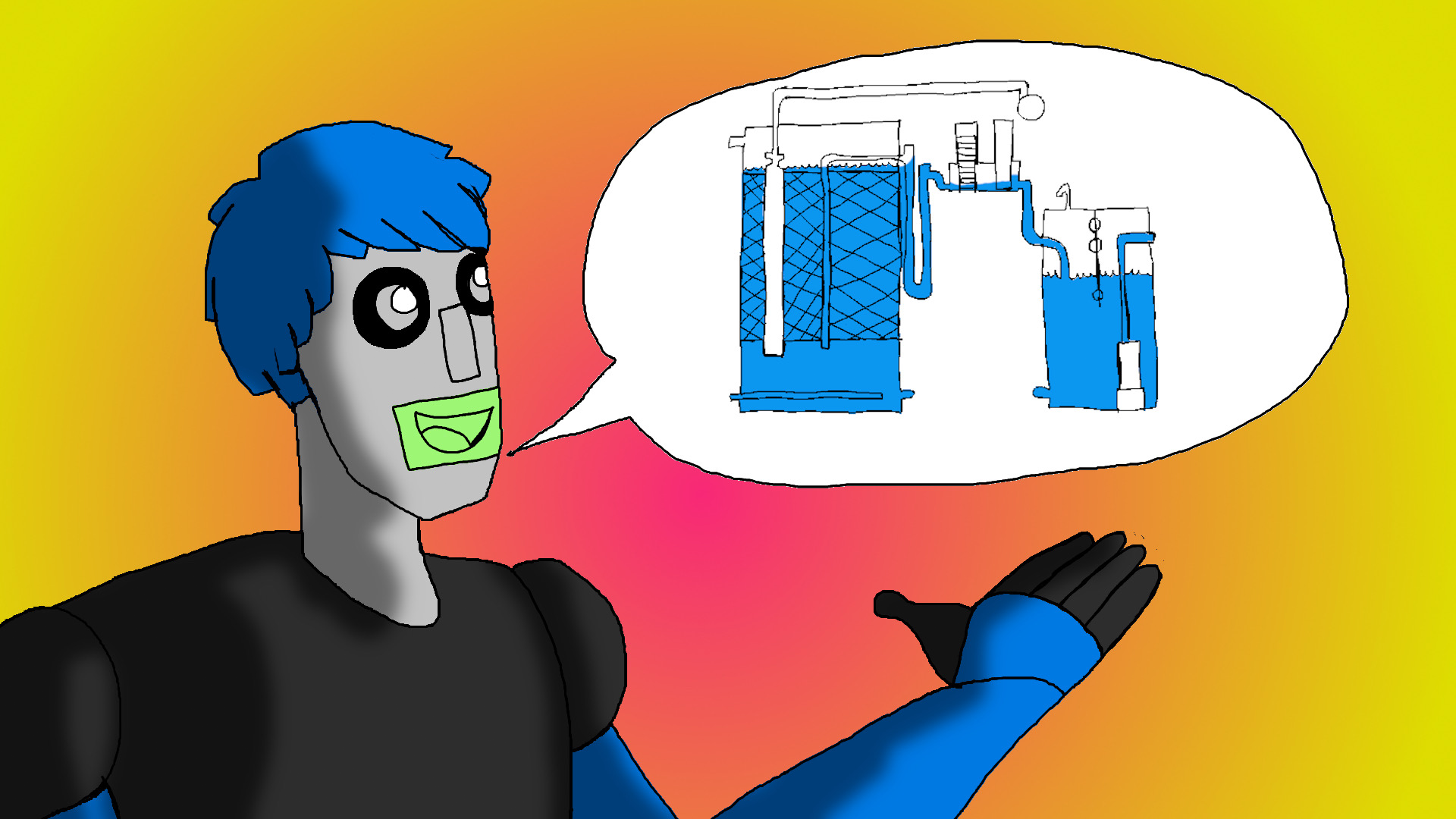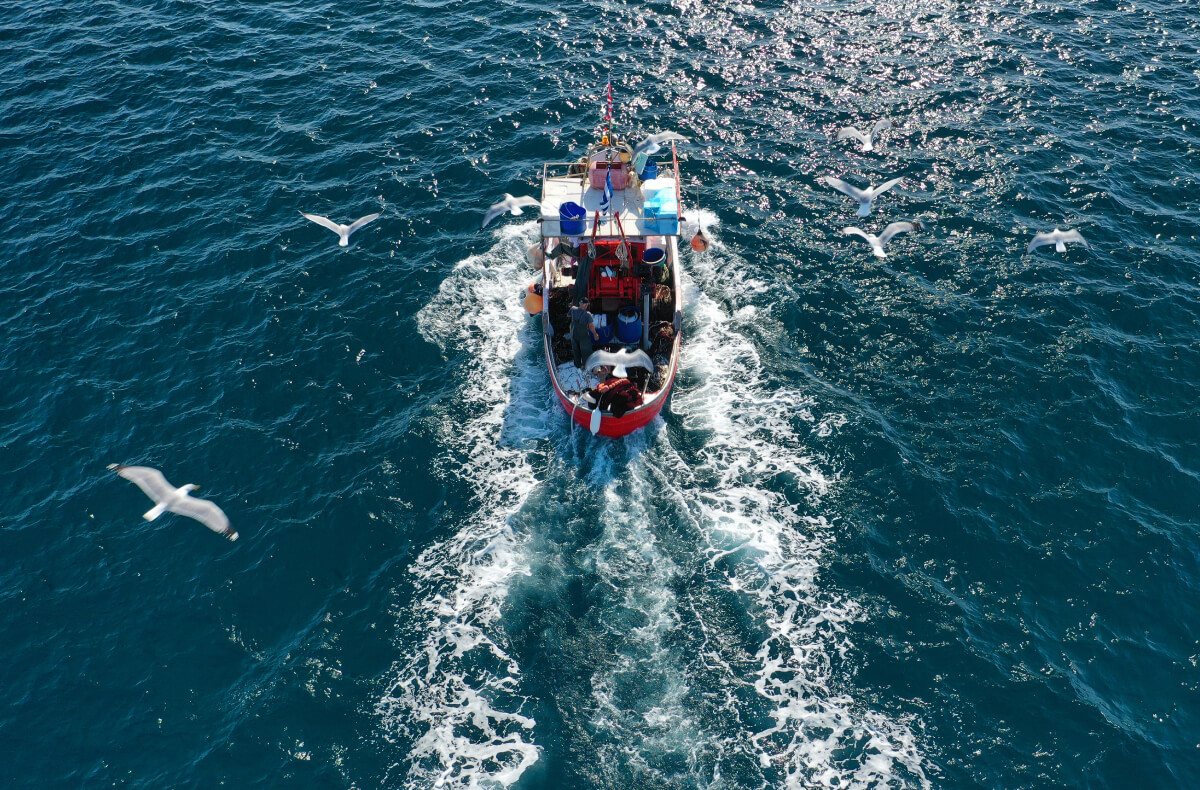Synopsis: Systems that dilute wastewater before depositing it into the ocean will deposit concentrated wastewater when they fail – violating environmental regulations.
Application: The MarineFAST® treats, rather than dilutes, wastewater, and operates without needing to release wastewater into the ocean.
Chief Engineer Marty Mariner was having issues with the Whale Two-AH System onboard the M/V-Red Putter diving vessel.
The Whale Marine Sewage Device, the Whale Two-AH, was having problems functioning because of some banana peels clogged inside the macerator. He either needed to fix it or replace it. When the system was specified in the shipbuilding phase, the space limitations were tight in the very back and lowest part of the ship. He thought that retrofitting a system was going to be near impossible.
At the end of his rope, he yelled out. “I need help…FAST®!”
He heard a “swoosh” on the port side of the ship and ran to see what it could possibly be.
There, on the deck, he saw the strangest man – mostly steel and a bit of plastic – was standing next to him. He was blue-and-gray-colored, and he had a logo that said “BioMicrobics” on his torso.

“What seems to be the trouble?” Robust said.
The Chief Officer gazed in amazement and stammered, “I…You…What?…Where did you come from?”
“I was just passing by when you called?” Robust said.
“I have a problem with my Whale Two-AH system. It is normally very reliable, and I am having trouble cleaning and maintaining the exchanger. There are rubber pieces in the hose from the impeller that is blocking water from flowing into the system,” said Marty Mariner.
Robust thought about the problem for a long time. He looked like he had been in many of these situations before, and he did know much about the Whale Two-AH system.
After thinking for a long time, Robust said, “How about using a MarineFAST® system?”
“I have never heard of that before. Will it treat up to five hundred people?” says Chief Engineer Marty Mariner.
“It can treat up to 104 people. So you are going to have more than enough treatment with a large, DV-Series, Scienco/FAST® system,” says Robust. “You see, in our system we treat the wastewater rather than dilute it. The MarineFAST® is much smaller than your system and it will treat the seawater. ”
“But the Whale Two-AH has the ability to use chlorine to disinfect the wastewater and it does not contain sludge. Also, it is a modular system and parts can be added to or taken away from the unit,” says Mariner.
“Well, it appears to me that your system has neither a settling tank nor a settling zone. The system uses a pump that floods with sea water to dilute the masticated waste that sent the wastewater to the tank with hypochlorite. The retention time was too short for any treatment and the hypochlorite generator was not producing enough chlorine to disinfect the sewage before being dumped into the sea. In short, they were violating the regulations and couldn’t keep the system running – not even the Whale-Two-AH people could get it fixed.
“Also, our systems have Calcium-Prevention Treatment loaded onto the system that is able to prevent any calcium build-up from the sea in the system,” says Robust.
“I can see that benefit, but what about the way water is used in the MarineFAST? What happens to it?” asks Mariner.
“The water in our system is used in a continuous flow. It has no need to be dumped overboard into the sea.”

After thinking hard on the manner for a long time, Marty Mariner decided that he would like to continue to know more about the MarineFAST and that he might dispose of his Whale Two-AH System.
“I am interested in the MarineFast Design Guidelines. How were the sewage service factors developed? What restrictions are these factors based on? BOD? Please give me a call, for I will need to know more information.” said Mariner.
“The service characteristics are based on applied per capita BOD5. The volume of water used to transport the BOD5 is practical only because it is necessary to make reasonable theories of maximum and minimum flows in order to design piping, pumps, contact volumes, and more. We have been analyzing the literature for many years and have incorporated credible data as it is published. The household figures have been adjusted for two factors. One fact is that the people are not at home 24 hours per day. The ship is a closed environment and a marine sewage treatment system will get 100% of the business. The second fact is that commercial vessels are able to treat all-adult populations rather than persons of all ages as reflected in household data. In my opinion, these are the very best data available and we use them in our own equipment designs,” said Robust.
Mariner replies, “I owe you a little more information on my effort. I am participating in a program called Marine Vessel Environmental Performance (MVeP), in partnership with the Society of Naval Architects and Marine Engineers. The purpose of MVeP is to develop a quantitative method of evaluating vessels for their holistic environmental impact, and guide operators on good practice and suggested environmental equipment. I personally am working on creating a metric by which to measure the total sewage expulsion of a vessel.”
Robust says, “I am happy to hear that the factors are based entirely on BOD5, and they are changed to marine applications over time. I have a couple of other questions that may need to be answered as well. With BOD5 as a driving factor in sizing a treatment system, would you consider this constraint the most important when gauging environmental impact? Or is BOD5 simply the most stringent requirement to meet? The provided population equivalents give very useful numbers for developing a metric. Has there been any work on cruise ship information? I understand that the sizing of a cruise ship system takes special consideration of both the nature of the ship’s waste and the increased passenger load. Could you provide example certification test data for one of the systems? Have the systems been tested under MARPOL resolution MEPC.159 (55)? It seems most regulatory societies type-approve under these requirements. I am trying to get a flavor of what the testing and certification process looks like, and which restrictions are tested to meet regulatory requirements.”
Robust replies, “Thanks for your interest. Although I am a member of SNAME, I was not aware of this Committee. I am currently serving in the ASTM F-25 06 workgroup to develop an ASTM standard for marine sewage treatment systems.
First of all, BOD5 is the key factor in determining the environmental impact of the wastewater stream. By definition, it measures the amount of oxygen that will be depleted from the receiving waters during a five day period.
Although the biological oxidation of this organic material is a natural process, the sheer volume and concentration of wastewater discharged into harbors and other waterways can exceed the ability of the environment to respond.
EPA standards for secondary treatment require removal of not less than 85% of applied BOD5 and also TSS, substantially reducing the environmental impact of the wastewater. Unfortunately, marine regulations do not address removal and deal only with concentration, thereby creating any number of USCG and IMO certified “dilution machines”. Dilute the wastewater does not reduce the environmental impact in terms of oxygen demand.”
Mariner says, “Our primary concern here has been to develop data for use in designing equipment for commercial vessels and very little data is available for cruise ships. I have enclosed a copy of EPA’s Cruise Ship Discharge Assessment Report. It appears that the major difference between cruise ship wastewater and that from other commercial vessels relates to an incredible degree of waste from the kitchens. My opinion is based upon the following: The organic loading from blackwater is a matter of human bodily processes and is not reliant on the type of vessel. Similarly, people get dirty, take showers and wash clothes, bedding, and towels when they are not aboard a cruise ship. There is so much that is not organized in all of the available data that I suspect that this loading from sources other than kitchen waste doesn’t vary too much from the average. I have taken a preliminary stab at that in the enclosed printout. It illustrates two main points. Just how much data is available in the public domain for domestic wastewater? Just how little data is available for cruise ships? With regard to the size of the population, to me the per-capita figures multiplied by the population to determine the loading. I can’t see it being anything but linear.
“Your information on BOD, and an introduction to the issue of ‘dilution machines,’ have been very helpful in guiding the development of our metric. In using BOD5 as our quantifiable metric, it makes very good sense that use of a dilution machine should not be rewarded, as it does not remove BOD5, and, in some ways, does not actually mitigate the environmental impact of an expulsion.”
“I have also attached the MVEP Phase 1 Report, which is now somewhat outdated, but gives a general idea. I would like to reference the data you provided for BOD loading of different waste streams in our published metric, and wanted to check with you if this would be okay. It seems to me that FAST® is one of the progressive companies that are working to improve the industry’s position on wastewater treatment, and I would really like to use your Marine/FAST®,” said Mariner.
“You made a good choice, and remember: Better Water. Better World,” said Robust.







